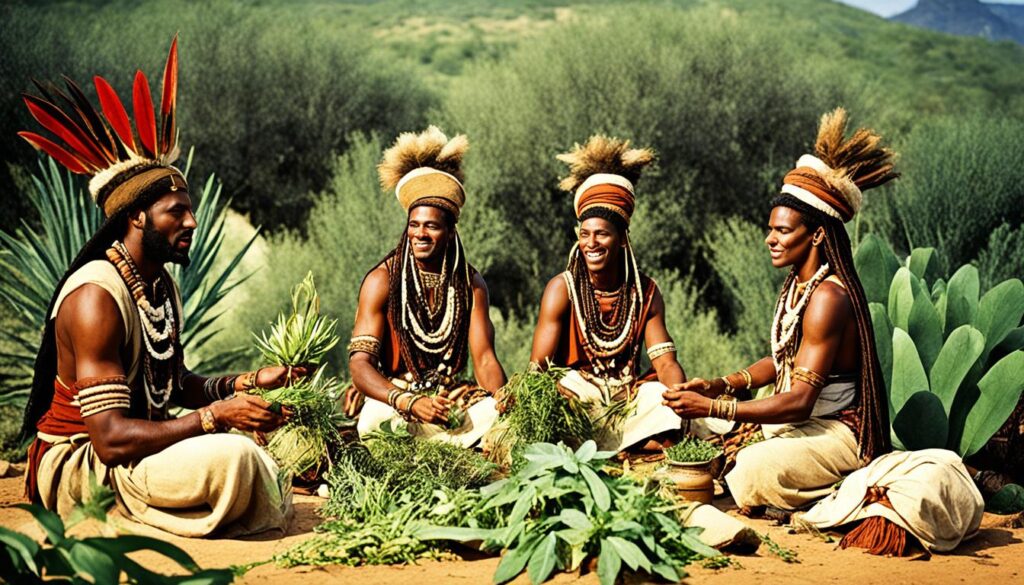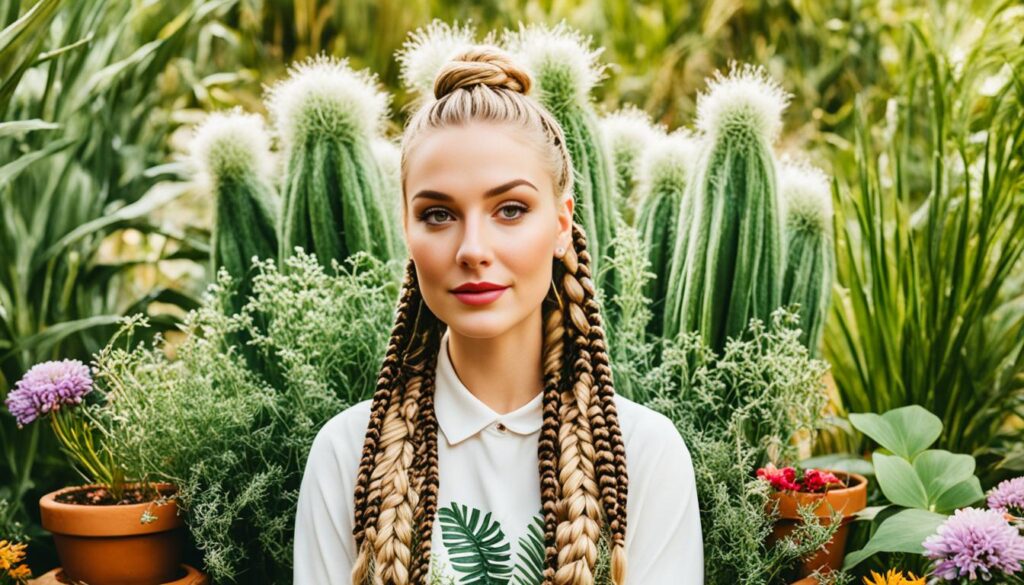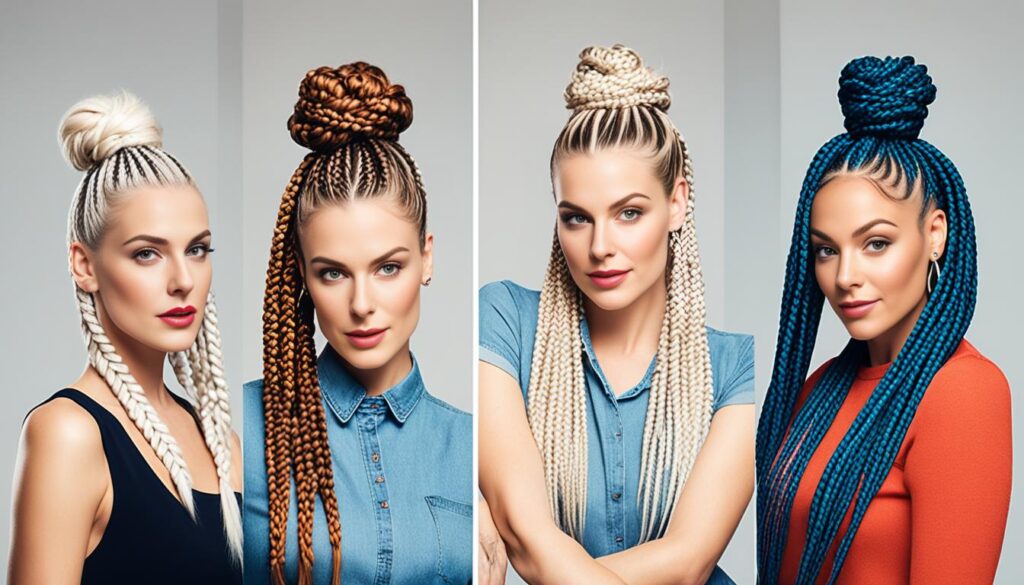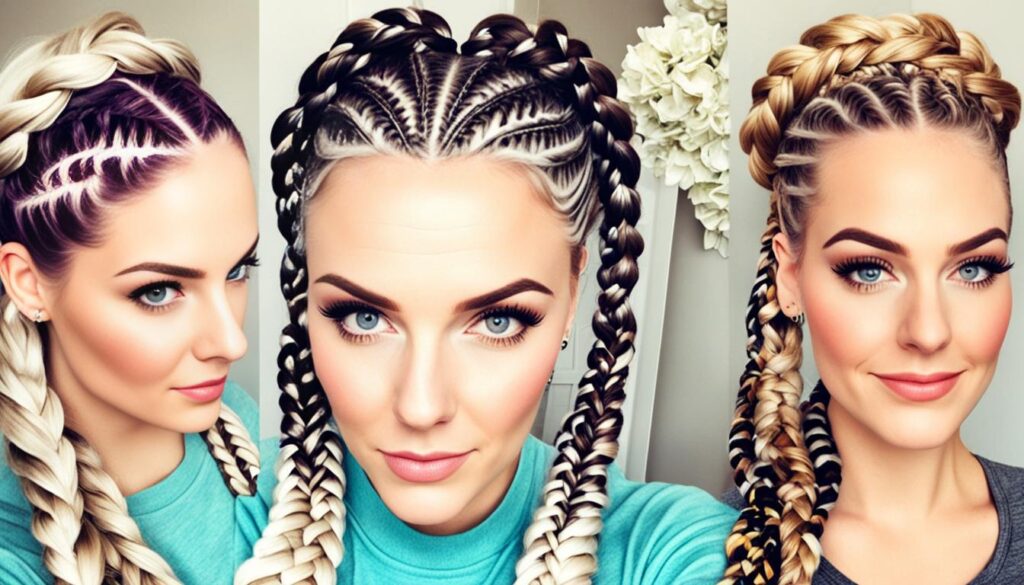Welcome to our latest article on the controversial topic of white girls wearing box braids. In recent years, the trend of white girls embracing natural hair styles, including box braids, has become a hot-button issue within the natural hair community. Some view it as cultural appropriation, while others see it as a celebration of diverse beauty. Today, we dive into the debate surrounding white girl box braids, exploring the various perspectives and shedding light on this complex topic.
For some, box braids are more than just a hairstyle; they are a symbol of self-expression, heritage, and cultural pride. Black women have been wearing braids as a protective style for centuries, providing ease in hair care and an opportunity to embrace their natural hair texture. However, the question arises when white girls adopt this hairstyle without understanding its historical significance. This debate centers around cultural appropriation and the potential erasure of the experiences of black women.
Throughout this article, we will delve into the cultural significance of braids for black women and the historical context of black hair. We will examine the appropriation debate and the impact that societal attitudes towards natural hair have on black women’s lives. Additionally, we will discuss the natural hair movement and the role of white women in this space. By gaining a deeper understanding of these issues, we can foster greater empathy and promote inclusivity in our conversations about natural hair.
So let’s explore the multifaceted topic of white girl box braids together, recognizing the importance of embracing diversity while respecting the experiences of marginalized communities. Join us as we navigate this thought-provoking discussion and strive for a more inclusive and understanding society.
The Symbolism of Braids for Black Women
When it comes to black women, braiding their hair goes beyond mere hairstyling. Braids hold great symbolism, representing self-love, heritage, and culture. More than just a trendy fashion statement, braids serve as a protective style that saves time and effort in hair care. For centuries, black women have adorned their hair with braids as both a necessity and a powerful expression of their identity.
The cultural significance of braids for black women cannot be overstated. They have served as a form of self-expression, allowing black women to embrace the beauty of their natural hair and celebrate their heritage. From intricate cornrows to elegant box braids, these hairstyles showcase the versatility and creativity that black women bring to the world of hair braiding.
The Art of Braiding: A Reflection of Tradition and Creativity
Braiding is a skill that has been passed down through generations, creating a connection to ancestral roots and preserving cultural traditions. Learning to braid is not only an art form but also a way to honor the elders who passed this knowledge onto future generations.
“Braiding is an art form that connects us to our ancestors and roots. It is a celebration of our culture and a way to express our identity.” – Jasmine Wright, a renowned hairstylist specializing in braided hairstyles.
Braids also provide an avenue for creativity and self-expression, allowing black women to experiment with different styles, colors, and patterns. From classic cornrows to elegant twists, there is a wide range of braiding techniques that showcase black women’s innovation and unique sense of style.
Braids as a Protective Style
Braids offer numerous benefits beyond their cultural and aesthetic significance. They are a practical choice, serving as a protective style that helps preserve and nourish natural hair. By tightly braiding the hair, black women can minimize breakage caused by everyday activities and protect their strands from harsh environmental factors.
Furthermore, braids allow for low maintenance hair care routines, saving valuable time and effort. Regularly moisturizing the scalp and applying natural oils can help maintain the health and luster of the hair while it is in a braided state. This convenience makes braids an ideal choice for black women who lead busy lives.
To complement this section, take a moment to appreciate the beauty of braided hairstyles:
Empowerment Through Braids
The act of braiding holds a deep sense of empowerment for black women. It represents an affirmation of their natural hair texture, challenging societal norms and Eurocentric beauty standards. By embracing braids, black women break free from the constraints of conformity and celebrate their unique beauty.
From the powerful history behind braided hairstyles to the cultural pride exuded by black women who wear them, braids are more than just a hairstyle. They are a symbol of resilience, heritage, and the ongoing journey towards self-acceptance. Through the art of braiding, black women continue to define and shape the world of natural hair.
The Appropriation Debate
The debate around white girls wearing black hairstyles like dreadlocks and cornrows revolves around the issue of cultural appropriation. Cultural appropriation refers to the adoption or use of elements from a culture by members of another culture, often without understanding or respect for the historical and cultural significance.
Many argue that white women wearing these styles, such as white girl dreadlocks and white girl cornrows, without acknowledging their origins and cultural context is disrespectful and trivializes the experiences of black women. They believe that these hairstyles are deeply rooted in black culture and have been historically used as a form of self-expression, resistance, and cultural identity.
White girls wearing dreadlocks and cornrows without understanding their history and cultural significance is disrespectful and trivializes the experiences of black women.
On the other side of the debate, some argue that hairstyles should not be limited to a specific racial or ethnic group. They believe that hairstyles, like any form of self-expression, should be accessible to anyone, regardless of their background. They argue for the importance of cultural exchange and the celebration of diversity.
It is crucial to acknowledge and understand the perspectives of both sides in this debate, as it involves issues of identity, race, and cultural heritage. The discussion should be approached with empathy, respect, and a willingness to learn and grow.
Historical Context
The historical context plays a significant role in this debate. Hairstyles like dreadlocks and cornrows have deep roots in African and African-American culture. They have been used for centuries as a way to express African heritage, unity, and resistance against oppression.
During the era of slavery, when enslaved people were stripped of their culture and forced to conform to Eurocentric beauty standards, hairstyles like dreadlocks and cornrows became even more meaningful. They served as a symbol of defiance and a way to preserve African cultural traditions.
Understanding the historical context can help us grasp the cultural significance of these hairstyles and why their appropriation can be hurtful to those who have endured historical marginalization and discrimination.
Respectful Appreciation
The appropriation debate should not discourage cross-cultural appreciation or discourage people from experimenting with different hairstyles. However, it is essential to approach cultural elements with respect and a desire to learn and understand their origins.
Appreciating and celebrating diversity should not come at the cost of undermining the experiences and cultural contributions of marginalized communities.
By educating ourselves, showing respect, and engaging in meaningful conversations, we can foster a more inclusive and understanding society.
Perspectives on the Appropriation Debate
| Arguments in Favor of Cultural Appreciation | Arguments Against Cultural Appropriation |
|---|---|
|
|
It is important to approach discussions about cultural appropriation with sensitivity and open-mindedness. By understanding the perspectives of both sides and engaging in respectful dialogue, we can move towards a more inclusive and culturally aware society.
The History of Black Hair
Black hair is not “just hair.” It carries within it a rich and profound history that spans centuries and cultures. From ancient African hairstyles to the struggles faced by black women in embracing their natural hair today, the significance of black hair goes far beyond personal style.
In African tribes, hairstyles held cultural and spiritual value. They were not simply a means of self-expression but a reflection of one’s identity, social status, and tribe affiliation. Intricate braids, locs, and intricate hair adornments were a part of everyday life and showcased the artistry and craftsmanship of hair styling.
However, the era of slavery brought immense challenges to the preservation of black hair culture. Enslaved black people were forced to shave their heads, stripping away their cultural identity and connection to their roots. Eurocentric beauty standards, which favored straight hair, further marginalized black hair.
The Struggles of Black Women
For black women, the journey towards embracing their natural hair has been marred by societal pressure and prejudice. Eurocentric beauty standards have long equated straight hair with beauty and professionalism, while natural black hair has often been deemed unattractive or unprofessional.
The struggles faced by black women in accepting and embracing their natural hair are deeply rooted in historical and systemic racism. The pressure to conform to Eurocentric ideals has caused many black women to chemically straighten their hair or wear extensions to fit into societal norms.
| Black Hair Challenges | Impact |
|---|---|
| Discrimination in the workplace | Black women with natural hair often face discrimination and bias when it comes to hiring, promotions, and workplace policies. |
| Unfair school dress codes | Black girls have been disproportionately targeted and disciplined for wearing natural hairstyles that are deemed “distracting” or “unprofessional.” |
| Misrepresentation in media | Mainstream media often perpetuates negative stereotypes about black hair, reinforcing the idea that it is unkempt or undesirable. |
| Pressure to conform | Many black women feel societal pressure to conform to Eurocentric beauty standards, leading to the use of chemical relaxers or weaves. |
Despite these challenges, there has been a growing movement of black women embracing their natural hair, reclaiming their heritage, and challenging societal norms. The natural hair movement has provided a space for black women to celebrate their hair, connect with their roots, and inspire others to do the same.

Understanding the historical context of black hair is essential in appreciating the resilience, strength, and beauty that it represents. Black hair is not just a hairstyle; it signifies a deep connection to culture, history, and self-expression.
The Impact on Black Women’s Lives
Black women have long been subjected to discrimination and bias in various aspects of life due to their natural hair. These biases manifest themselves in various ways, from workplace discrimination to school dress codes. Black hairstyles, such as box braids, have been unfairly deemed as “unprofessional,” leading to negative stereotypes and unequal treatment. The societal attitudes towards black women’s natural hair have had a profound impact on their lives and experiences.
One of the most significant areas where black women face discrimination is in the workplace. Many black women report being treated differently or even facing barriers to employment because of their natural hair. Hairstyles like Caucasian box braids tutorial are often seen as unprofessional or unkempt, despite being a beautiful and culturally significant expression of black identity. This bias not only affects job opportunities but also impacts the overall well-being and self-esteem of black women in professional settings.
“The biases against natural hair are deeply rooted in racism and Eurocentric beauty standards. Black women should not have to conform to white standards of beauty to be accepted or respected in society.”
– Angela Davis
In addition to workplace discrimination, black women also face challenges in educational settings. Many schools have dress codes that explicitly ban hairstyles commonly worn by black women, including box braids. These policies unfairly target and stigmatize black students, sending the message that their natural hair is unacceptable or inappropriate. As a result, black girls may feel pressured to alter their hairstyles or even face disciplinary action for embracing their cultural identity.
It’s important to recognize that the impact of these biases goes beyond superficial appearance. The discrimination against black women’s natural hair contributes to a larger system of systemic racism and inequality. It reinforces harmful stereotypes and perpetuates the notion that black features are lesser or undesirable. These attitudes have lasting effects on black women’s self-esteem, mental health, and sense of belonging.
The Need for Change
Addressing the impact of societal attitudes towards black women’s natural hair requires a collective effort to challenge and dismantle racist beauty standards. It begins with education and awareness, promoting inclusivity and celebrating the beauty of diversity.
- Employers and organizations must implement policies that explicitly prohibit discrimination based on hairstyles or natural hair texture. They should create inclusive spaces where employees feel embraced and accepted for their authentic selves.
- Educational institutions should revise dress codes to ensure they do not disproportionately target students of color. They should encourage cultural sensitivity and celebrate diversity in school environments.
- Society as a whole must confront and unlearn biases against natural hair by promoting representation and visibility. Media, fashion, and beauty industries should actively include and uplift black women with natural hair, showcasing their beauty and challenging narrow beauty standards.
By collectively working towards a more inclusive and accepting society, we can create a future where black women are not judged or discriminated against for their natural hair. It’s time to embrace and celebrate the beauty of diversity in all its forms.
The Natural Hair Movement
The natural hair movement has sparked a revolution in the way black women perceive and embrace their hair. It is a powerful and empowering movement that celebrates the beauty and versatility of natural hair textures, challenging societal beauty standards and promoting self-acceptance.
For decades, black women have been conditioned to believe that their natural hair is unprofessional or not socially acceptable. However, the natural hair movement has given them a platform to reclaim their identity and reject these damaging stereotypes.
Box braids for white girls have become a popular trend within the natural hair movement. These protective hairstyles not only provide a stylish look but also help to protect the hair from damage and promote healthy growth.
The significance of box braids goes beyond just a fashionable hairstyle. It symbolizes unity, strength, and cultural pride. By embracing box braids, white girls are not only appreciating the aesthetics but also acknowledging and respecting the cultural roots of this hairstyle.
“The natural hair movement is not about excluding anyone, but rather creating a space where women of all backgrounds can celebrate and embrace their natural hair.” – Chimamanda Ngozi Adichie
White Girl Protective Hairstyles
White girls also benefit from the natural hair movement by exploring protective hairstyles that promote hair health and growth. These hairstyles are not limited to any specific race or ethnicity but provide practical solutions for maintaining and caring for all hair types.
When considering protective hairstyles, it’s important for white girls to educate themselves on proper techniques and understand the cultural significance behind the styles they choose. This awareness fosters respect and appreciation for the diversity and heritage associated with different hairstyles.
By experimenting with protective hairstyles, white girls can also break free from the confines of traditional beauty standards and embrace their natural hair textures without feeling the need to conform to societal expectations.
In conclusion, the natural hair movement has had a profound impact on black women’s self-image and the way society perceives natural hair. It is a movement that encourages inclusivity and promotes self-love and acceptance for all women, regardless of their race or ethnicity. By participating in the natural hair movement, white girls can not only embrace beautiful protective hairstyles but also contribute to a more diverse and inclusive beauty industry.

Comparing Protective Hairstyles
| Hairstyle | Benefits | Cultural Significance |
|---|---|---|
| Box Braids | Protects hair from damage, promotes growth, and offers versatile styling options | Originates from African cultural traditions and symbolizes unity and strength |
| Cornrows | Keeps hair secure and orderly, ideal for active lifestyles, and protects from breakage | Deeply rooted in African history and culture, represents social and religious identity |
| Dreadlocks | Requires minimal maintenance, protects hair, and symbolizes spirituality and cultural pride | Associated with reggae culture and Rastafarianism, represents a spiritual journey |
The Role of White Women
The involvement of white women in the natural hair space has sparked debates about inclusion and appropriation. While some argue that the movement should remain exclusive to women of color, others believe that the movement should be inclusive and that white women can also participate in conversations about natural hair. This section explores the different perspectives on the role of white women in the natural hair movement.
Embracing Diversity
One perspective argues that the natural hair movement should be a space for all women, regardless of race. They believe that embracing diversity and inclusivity is essential for promoting understanding and breaking down barriers. By including white women in conversations about natural hair, it allows for a broader appreciation of different hair textures and cultivates a sense of unity among women.
“Inclusivity in the natural hair movement allows for a greater understanding of the experiences and struggles faced by women of all races. It’s an opportunity for learning, growth, and solidarity.” – Sarah, Natural Hair Enthusiast
The Appropriation Debate
On the other hand, some argue that the natural hair movement should be exclusive to women of color as a way to reclaim their culture and identity. They believe that allowing white women to participate in conversations about natural hair, especially when it comes to hairstyles like white girl box braids, can perpetuate cultural appropriation. This argument emphasizes the importance of honoring the historical and cultural significance of specific hairstyles within the black community.
“As a black woman, my natural hair journey is deeply tied to my heritage and identity. It’s important that the natural hair movement remains a space where our experiences are central and celebrated.” – Jasmine, Natural Hair Advocate
Seeking Allies and Support
Another perspective advocates for white women to be allies in the natural hair movement. They believe that white women can use their privilege to amplify the voices and experiences of women of color and contribute to the dismantling of Eurocentric beauty standards. This approach encourages a collaborative effort towards creating a more inclusive and accepting society.
“White women can play a crucial role in challenging societal norms and amplifying the voices of women of color. By becoming allies, we can create a powerful force for change and inclusivity in the natural hair movement.” – Emily, Ally Advocate
While there are differing opinions surrounding the role of white women in the natural hair movement, it is clear that these conversations are important in promoting dialogue, understanding, and cultural appreciation. By fostering an environment of inclusivity, acceptance, and respect, we can work towards a future where all women can embrace their natural hair and feel empowered.

Understanding the Differences
When discussing hair struggles, it is crucial to recognize and respect the distinct experiences faced by black women and white women. While some white women may have encountered societal pressure to straighten their naturally curly hair, it is essential to acknowledge that their experiences do not compare to the discrimination and bias endured by black women.
Black women have a long history of facing stigma and judgment based on their natural hair texture. From being told their hair is “unprofessional” or “unkempt” to being subjected to discriminatory practices and policies, black women have fought an uphill battle to embrace and celebrate their unique beauty.
On the other hand, white women often have a wider array of hair options and less social pressure to conform to a particular standard of beauty. This privilege allows for more experimentation and flexibility in hairstyles without the same level of scrutiny or consequences.
It is important to recognize and understand these differences in experiences and challenges faced by women of different ethnicities. By doing so, we can foster empathy, promote inclusivity, and work together to create a more equitable and understanding environment.
The Importance of Education
One way to bridge this gap and promote understanding is through education. By learning about the historical and cultural significance of different hair textures and hairstyles, we can gain insight into the experiences of others and develop empathy. Educating ourselves about the struggles faced by black women in the natural hair community can help create a more inclusive and supportive space for everyone.
“Educating ourselves about the struggles faced by black women in the natural hair community can help create a more inclusive and supportive space for everyone.”
Exploring Hair Braiding Techniques
When it comes to hair braiding techniques, it is important to note that there are differences between black hair and white hair. The texture, thickness, and porosity of these hair types vary, which can affect the type of braiding techniques that work best.
While cornrows, a popular braiding style, are often associated with black hair, white women can also experiment with different variations of this style. However, it is crucial to approach the technique with a willingness to learn and respect its cultural origins.
White Girl Hair Braiding Techniques
| Technique | Description |
|---|---|
| Dutch Braids | A type of inverted braid that creates a raised effect on the hair. This technique is suitable for both black and white hair. |
| Fishtail Braids | A braiding technique that creates a woven pattern similar to the structure of a fish’s tail. This technique can be adapted for different hair textures. |
| Halo Braids | Braids that encircle the head like a halo. This technique works well for various hair types and can be a beautiful and versatile option for white women. |
Remember, it is crucial to approach hair braiding techniques with cultural sensitivity and respect. Understanding the origins and cultural significance of different styles can help foster appreciation and avoid appropriating or trivializing black hairstyles.

Conclusion
The debate surrounding white girls wearing box braids is a complex and multifaceted one, touching on cultural appropriation, representation, and understanding. We must approach this conversation with empathy and openness to different perspectives. It is crucial to recognize and respect the history and experiences of black women in the natural hair movement, as their struggles with acceptance and discrimination are deeply rooted.
However, as we navigate this discussion, it is also important to promote inclusivity and self-acceptance for all. Encouraging individuals to embrace their natural hair, regardless of their ethnic background, can foster a sense of unity and empowerment. By learning from each other’s experiences and engaging in meaningful dialogue, we can work towards a more inclusive and understanding society.
Ultimately, the decision to wear box braids as a white girl should be guided by respect for the cultural significance and origins of the hairstyle while celebrating the beauty and diversity of natural hair. Let us strive for a conversation that bridges divides, promotes understanding, and fosters an environment where everyone feels empowered to express themselves authentically.